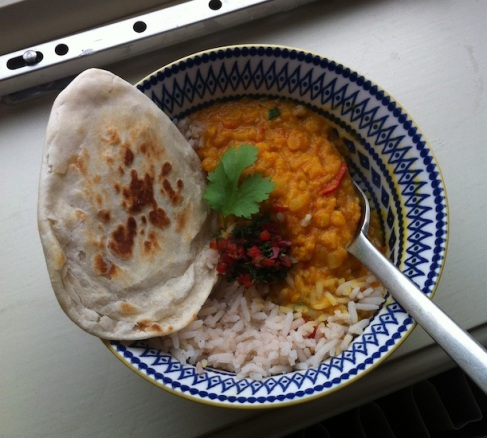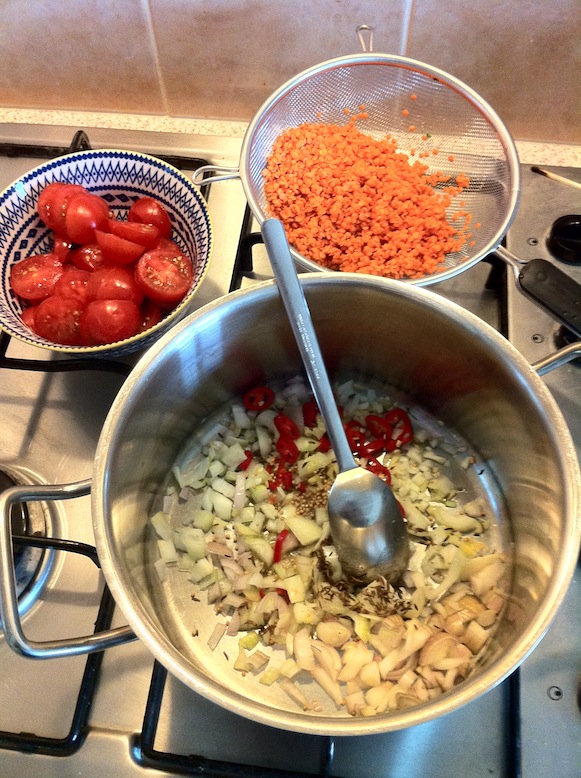Here’s one of our all-time favorites: healthy, satisfying, chock-full of complex warming flavors, this Indian-style spicy lentil stew has proven an effective antidote against Dutch weather. Its stress-free preparation makes it an ideal way of unwinding after day’s work.
Source improvement over a recipe from Vegetarisch Kochen Difficulty trivial Time 20 min for preparation; ~20 min for simmering Serves 2

Red lentil dal with basmati rice, here further served with homemade paratha bread and mint-coriander chutney (not included in this recipe).
Ingredients
- 150 g dry red lentils
- 300 g tomatoes (preferably small, tasty ones)
- 2 shallots or 1 smallish onion
- 1 clove of garlic
- 1 thumb of ginger
- 1 red hot chili pepper
- 1–2 tsp cumin seeds
- 1 tsp mustard seeds (if available)
- 1 tbsp clarified butter
- 100 ml coconut milk
- 1 cube of vegetable soup stock (intended for half a liter of soup)
- 1 tsp turmeric powder (kurkuma)
- hot water (about 200 ml)
- 1 lemon
- fresh coriander leaves (cilantro)
- 250 g basmati rice
You can probably find red lentils (they’re actually pale orange) in the «dry beans» part of your supermarket. If they don’t sell them, perhaps your local organic grocery shop will.
A word of warning for German-speaking nerds: cumin is Kreuzkümmel in German, which is not the same thing as the regular Kümmel (caraway) used in European cuisine. Don’t just substitute caraway; the exotic taste of cumin is essential for this dish. However, don’t worry if you don’t have mustard seeds at hand; their impact is minor.
Clarified butter is basically butter with all the solid components filtered out. You can use it like olive oil, eccept that it still tastes deliciously buttery. It might be hard to find in certain countries (such as the Netherlands, surprisingly), but you might be able to buy ghee, which is pretty much the same thing, in Indian specialty shops or organic food shops. In Switzerland, it’s called Bratbutter or Bratcrème; in Germany, Butterschmalz (look for the brand name «Butarys»). If you can’t find it, use a decent olive oil.
Preparation
Wash the red lentils in a sieve under running water and set them aside. Do the same thing with the basmati rice. Keep a water boiler full of hot water ready. If your coconut milk comes in a can, open it now so you won’t have to rush it later.
Wash the tomatoes and chilies; peel the shallots, garlic, and ginger. Cut the tomatoes into coarse chunks and store them in a bowl. Chop the chilies, shallots, garlic, and ginger into small pieces and toss them straight into the pan you’ll be cooking in.
Once you’re ready, add the clarified butter, cumin, and mustard seeds to the pan and gently sauté the contents. In case you’re unfamiliar with that word, simply turn up the heat to full until you start hearing sizzling sounds, then lower it to something like a 3 on a scale of 1–10 to keep the goods from browning too quickly. Shuffle them around with a turner or long spoon frequently to keep them from sticking on the pan. After a few minutes, the shallots should have taken on a glassy texture, and the smells should make your mouth water.
One after the other, add in the lentils, the tomatoes, the coconut milk, the soup stock, the turmeric, and the hot water.
Put a lid on the pan and leave the dal to simmer, stirring every now and then, until the lentils are pleasantly soft. You can add more water if the mass starts to stick to the bottom of the pan, or leave the lid off to boil away some water if it looks too runny. You’re aiming at a rich mushy pulp, not a watery soup.
Once the dal is in the simmering stage, set up the basmati rice to cook in another pan. You can just follow the instructions on the rice packaging. If there are none, try the following: Heat two cups of water (500 ml) with half a teaspoon of salt to a boil, add a cup of washed basmati rice (250 ml ~ 250 g), give it a stir, then put a well-fitting lid on the pan and turn down the heat. If you have a stove with metal plates, you should be able to switch if off entirely and use the residual heat of the plate and the pan to finish the cooking process. Don’t lift the lid prematurely! It should be ready after 15–20 minutes. Gas or induction stoves don’t stay hot after you switch them off, so turn the heat down to minimal for about 10 minutes before cutting it entirely. The rice should have soaked up the water, but if there’s a bit of liquid remaining, just drain it off before serving.
The dal and the rice should take roughly the same amount of time to cook. Before serving, add the coriander leaves and the juice of half a lemon (or an entire lemon, if you prefer a tart note) and give it a good final stir. Note that coriander is an acquired taste — depending on the tastes of your eaters, you might want to serve it separately, or leave it away entirely.
Variations
If you’re not in a hurry, I can recommend making some paratha and coriander-mint chutney to round out the feast, as in the image above… or cheat and just use store-bought pita bread, toasted and buttered. You can also use some or all of the rice to make lemon rice.


This looks fantastic. I love lentil dal. Thanks for sharing! Your blog is great! Love the recipes you have up. 🙂
Thanks for the kind words! I’m very impressed by your blog — will certainly try out that quiche of yours in the near future. 🙂
Well, thanks for stopping by! I hope you like that quiche – it’s soo good even though its much healthier than standard quiches. So good to have you! Looking forward to more of your deliciousness. 🙂
Pingback: Prosecco and shallot risotto | a nerd walks into a kitchen
Pingback: Tomato and Pine-Nut Risotto | a nerd walks into a kitchen
Pingback: Vegetable tajine, the way we like it | a nerd walks into a kitchen